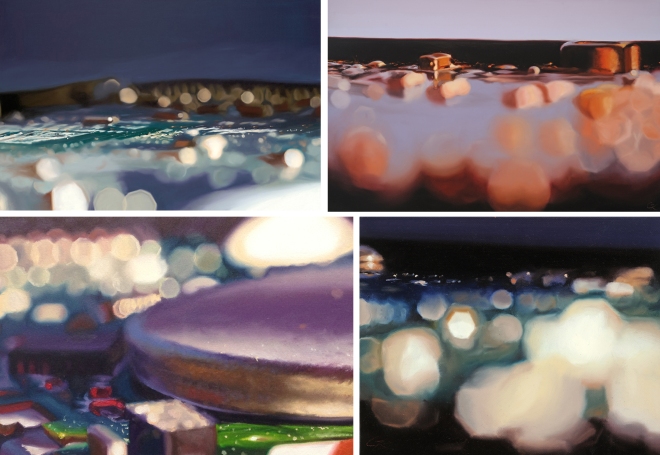
What is it?
“Bokeh” is a Japanese word that refers to the way that a lens renders points of light that are out of focus. In Japanese, the word means “blur” or “haze.” You’ve probably seen a lot of images with bokeh in them, even if you weren’t familiar with the term! Any image that includes a lot of relatively small points of light and highlight can be photographed in a way that features the bokeh– the blurred areas, particularly the circles of light.

An image of Boston by night featuring multiple areas of bokeh — photographer unknown
Examples from art history:
This is a tricky one! Giving examples from art history is pretty difficult, as photography itself is a relatively recent development in the span of history, and more advanced lenses that allow photographers to manipulate and take advantage of the pleasing effects of bokeh have come around even more recently. The term didn’t even show up in photography books until the 1990’s!
There were, however, some early 20th century pioneers of nighttime street photography who were beginning to capture the charming, multi-dimensional, glittering effect of blurred lights, as you can see in these two examples below:

(left) Brassaï, “Les Amoureux sur un Banc”; (right) Alfred Stieglitz, “A Venetian Canal”
“But Pam,” you must be thinking, “Principle Gallery doesn’t carry photography. Why write a Technique Tuesday post about something that isn’t going to be featured in Principle Gallery artwork too?”
First of all, I’m impressed that you knew it was Pam writing this post; well done. Secondly, that’s what is so cool about art– as time progresses as the world changes and technology moves forward, artists find amazing ways to incorporate brand new concepts into their age-old practice of painting! The act of applying colored pigment to a surface to create art may be ancient, but the creativity of artists and our changing world makes sure it never ever gets “old”! Let’s take a look.
Examples from Principle Gallery:
Bokeh is an effect that works really well with images of city lights. In fact, three artists instantly came to mind who have used a bokeh-type effect of blurred lights and highlights to give a glittering effect to their work:

(left) Nobuhito Tanaka, “Taipei Night”; (middle) Jonathan Gleed, “Night Lights; (right) Jeremy Mann, “After the Storm”
Another visually pleasing way to take advantage of bokeh is in macro photography, when images featuring a super-close-up of something also have points of selective focus to add to the texture, depth, and atmosphere of the work. It’s a bit difficult to just describe this photographic effect, so here’s an example of this in action, in a macro photo by photography Dimitar Lazarov:

Take a little of the city lights effect, a little of the macro-photography aspect, and add in a fresh and uniquely modern subject matter, and you have the magic of Glen Kessler’s circuitscapes.
Glen’s circuitscapes focus on close-up images of computer circuitboards and depicts them in a way that seems to transform them into something else: a city scene, a seascape, or something else familiar! Check out some of the amazing examples below (including one actually titled “Bokeh!”), which are all part of our Local Art, Local Eats exhibition, hanging now!

Glen Kessler Circuitscapes (top left) Circuitscape 15: Midnight in the Valley; (top right) Circuitscape 73: Fire and Water; (lower left) Circuitscape 25: Downtown Stadium; (lower right) Circuitscape 72: Bokeh


